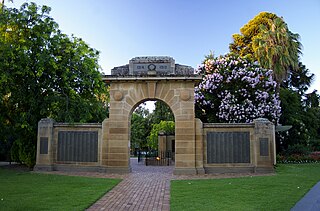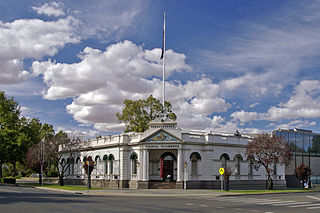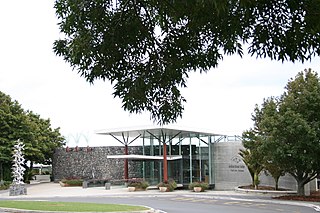
An arboretum is a botanical collection composed exclusively of trees of a variety of species. Originally mostly created as a section in a larger garden or park for specimens of mostly non-local species, many modern arboreta are in botanical gardens as living collections of woody plants and is intended at least in part for scientific study.

Wagga Wagga is a major regional city in the Riverina region of New South Wales, Australia. Straddling the Murrumbidgee River, with an urban population of more than 71,241 as of 2023, Wagga Wagga is the state's second largest inland city after Maitland, and is an important agricultural, military, and transport hub of Australia. The ninth largest inland city in Australia, Wagga Wagga is located midway between the two largest cities in Australia—Sydney and Melbourne—and is the major regional centre for the Riverina and South West Slopes regions.

Mount Keira is a suburb and mountain in the Illawarra region of New South Wales, Australia.

The San Francisco Botanical Garden at Strybing Arboretum is located in San Francisco's Golden Gate Park. Its 55 acres represents nearly 9,000 different kinds of plants from around the world, with particular focus on Magnolia species, high elevation palms, conifers, and cloud forest species from Central America, South America and Southeast Asia.
The Shing Mun Country Park is a country park of Hong Kong, hugging the Shing Mun Reservoir.
The London Borough of Bexley owns and maintains over 100 parks and open spaces within its boundaries, with a total of 638 hectares. They include small gardens, river and woodland areas, and large parks with many sporting and other facilities.


Victory Memorial Gardens are located on the banks of the Wollundry Lagoon in the central business district of Wagga Wagga New South Wales, Australia. The 2.02 hectares of land were formerly the site of the Old Police Barracks and Police Paddock, where all of the police horses were kept. It became land for public recreation in February 1931. In 1925 the Wagga Wagga Municipality Council planned a tribute to those who fought and died in the First World War. The Council and Returned Sailors, Soldiers Imperial League of Australia (RSSILA) originally planned a memorial hall to be added onto the council chambers but public preference was for gardens. There was a public competition for the design which was won by Thomas Kerr who was the chief landscape gardener of the Royal Botanic Gardens in Sydney. Work on the gardens started in 1928.

The Museum of the Riverina is a local history museum in Wagga Wagga, New South Wales, Australia. The Riverina is the region in south-western New South Wales in which Wagga Wagga is located. The museum was established by Wagga Wagga and District Historical Society in 1967 in premises near the Wagga Wagga Botanic Gardens on Lord Baden Powell Drive.

City of Wagga Wagga is a local government area in the Riverina region of southern New South Wales, Australia.

Centennial Parklands is the name given to a group of three urban parklands located in the eastern suburbs of Sydney, New South Wales, Australia. Comprising approximately 360 hectares, the lands encompass Centennial Park, Moore Park and Queens Park. The Parklands are listed on the New South Wales Heritage Register, with various components of national, state or local heritage significance. The parks are contained within the local government areas of City of Randwick, Waverley Municipal Council, and City of Sydney.

Bicentennial Park is a 40-hectare (99-acre) suburban parkland located 16 kilometres (9.9 mi) west of the Sydney central business district in the suburb of Sydney Olympic Park, in the local government area of City of Parramatta, New South Wales, Australia. Bicentennial Park is situated on the shores of Homebush Bay and is a part of the Sydney Olympic Park. The park is a natural heritage site featuring an important wetland ecosystem and parklands.

Gisborne Botanical Gardens is a public garden in Gisborne, New Zealand, that dates back to 1874. The Gisborne Botanical Gardens nowadays occupy 5.1 hectares (0.051 km2) between Aberdeen Road and the Taruheru River. There are still many trees remaining from the early period.

The Johannesburg Botanical Garden is located in the suburb of Emmarentia in Johannesburg, South Africa. The gardens grew out of a large rose garden that was established in 1964 and subsequently expanded from 1969 to cover an area of around 125 hectares (1.25 km2). It is administered by Johannesburg City Parks. The Emmarentia Dam is situated immediately to the east of the garden and shares its extensive acreage. One of the main attractions is the Rose Garden with over 10 000 roses.

Auckland Botanic Gardens is a botanical garden in the New Zealand city of Auckland. It is located in the suburb of Manurewa, in the Manurewa Local Board Area. The gardens cover 64 hectares, and holds more than 10,000 plants.

The Flora und Botanischer Garten Köln is a municipal formal park and botanical garden located adjacent to Cologne Zoological Garden at Amsterdamer Straße 34, Cologne, North Rhine-Westphalia, Germany. It is open daily without charge.

Allan Gardens is a conservatory and urban park located in the Garden District of Toronto, Ontario, Canada. The property includes a playground, off-leash dog park, and a 1,500 square metres (16,000 sq ft) conservatory with six green houses.

Queen's Park is a heritage-listed botanic garden at Sussex Street, Maryborough, Fraser Coast Region, Queensland, Australia. A reserve for the botanical gardens was gazetted in October 1873. It contains the Maryborough War Memorial. It was added to the Queensland Heritage Register on 21 October 1992.

Mossèn Costa i Llobera Gardens is a botanical garden in the center of Barcelona, Catalonia, Spain. It is situated at the foot of Montjuïc facing the sea. The park owes its name to the renowned Mallorcan poet Miquel Costa i Llobera.





















